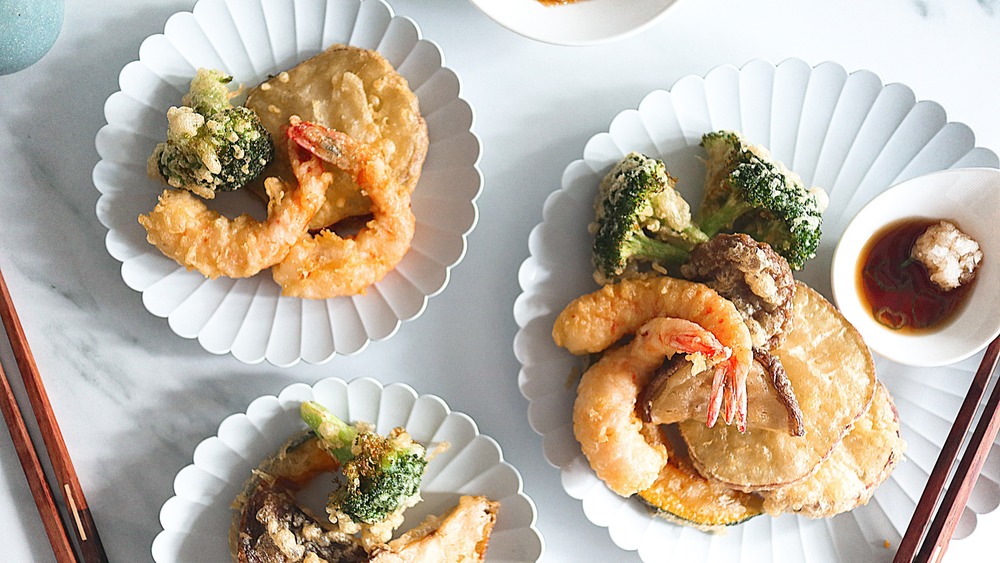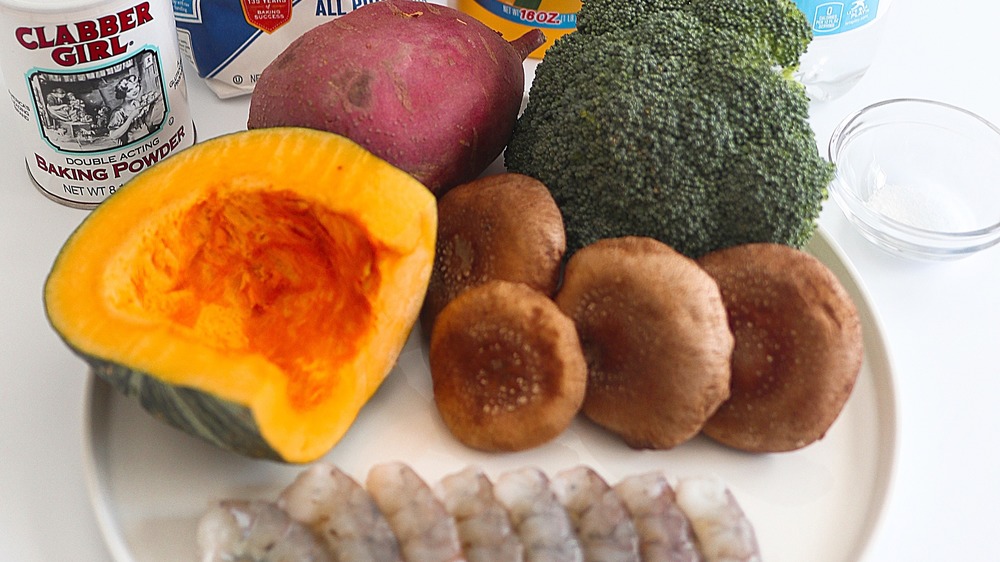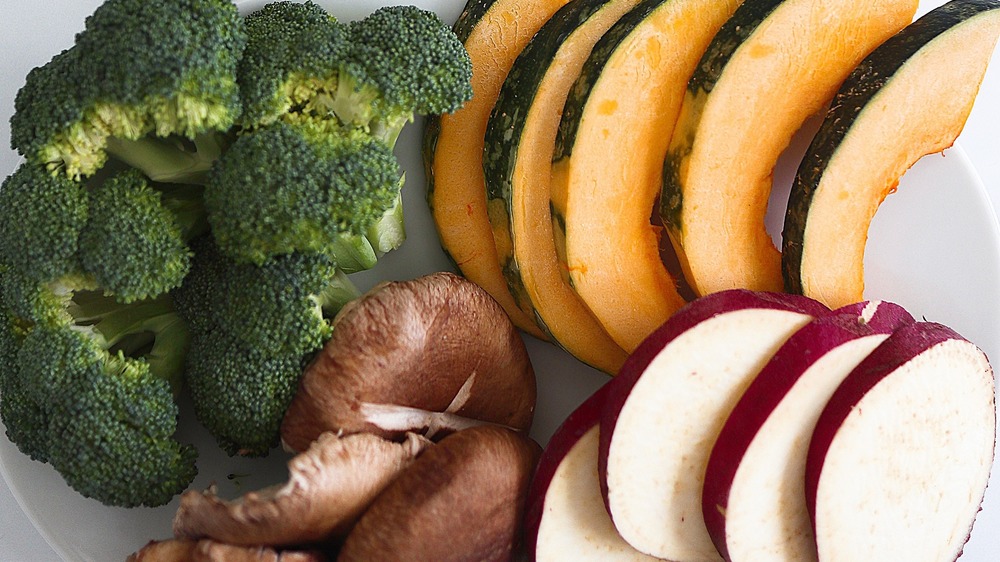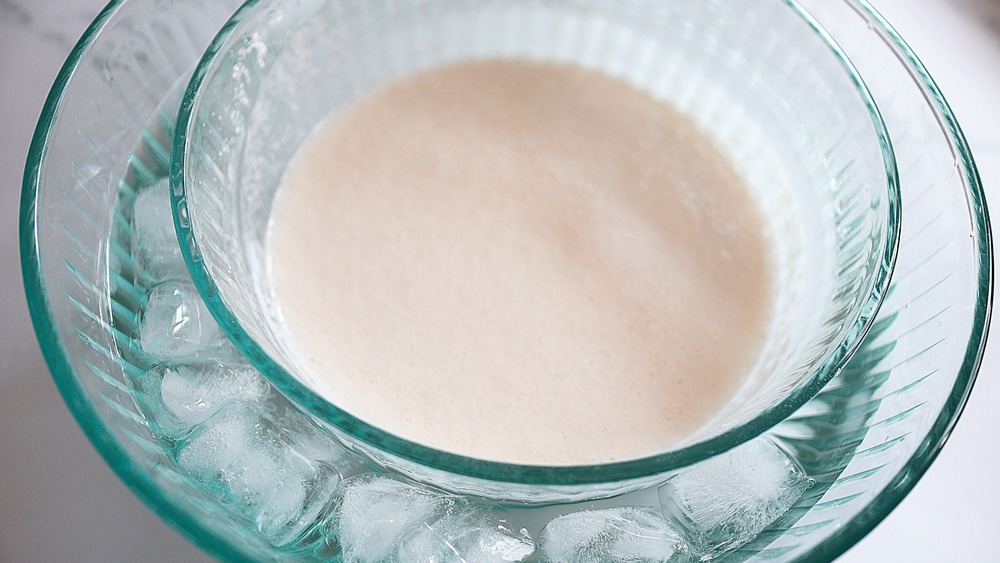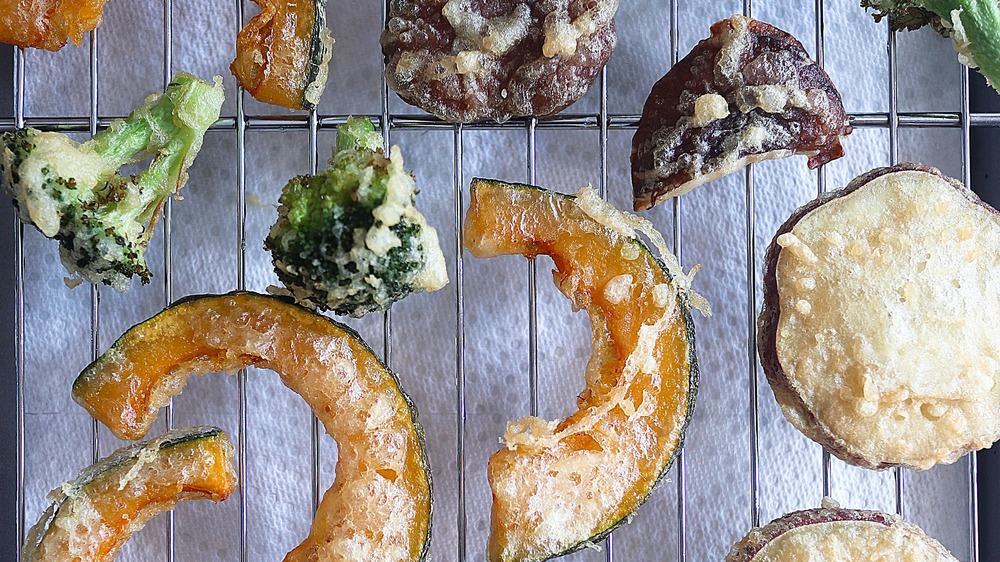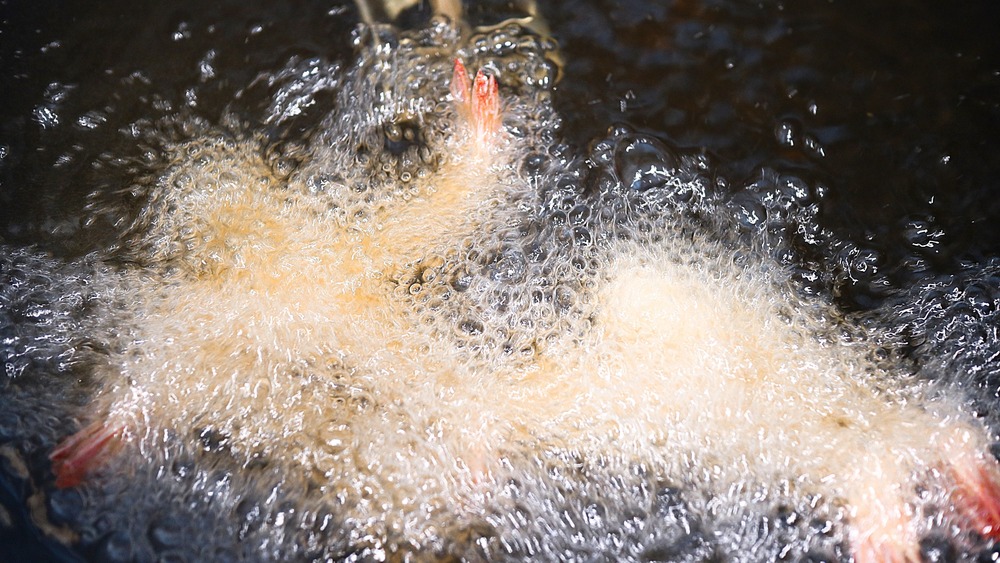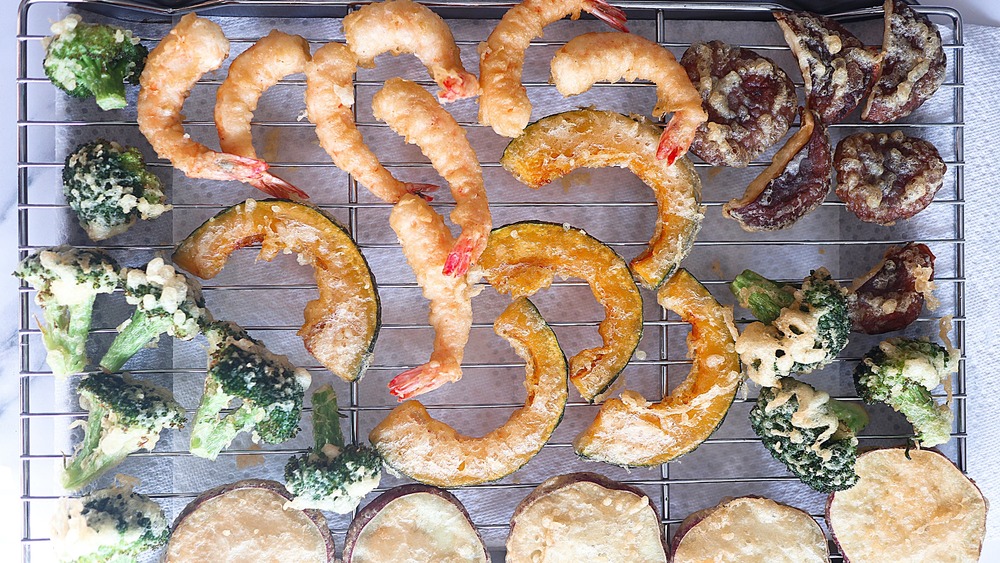Tempura Recipe
"Tempura is a Japanese dish consisting of seafood, meat, and vegetables that have been battered and deep-fried," says chef and recipe developer Cecilia Ryu. "The batter is extremely light and airy and also very crunchy. It is accompanied with a soy-based dipping sauce called tentsuyu." And while truly delicious, Ryu also allows that the beloved Japanese restaurant staple can scare off the home chef. "It can be intimidating to make, but if you have all the ingredients prepared and follow the directions step-by-step, you can enjoy delicious Japanese tempura at home," she says encouragingly.
Getting all those ingredients and putting the time in to get this recipe right is a commitment to be sure, but commensurate with your time and effort will be your pleasure with the final dish, not to mention the accolades you get from anyone lucky enough to try your homemade tempura.
Speaking of home, as it happens, tempura is not actually a homegrown Japanese dish. According to the BBC, the dish came courtesy of the Portuguese, who, for the later decades of the 16th century and first several decades of the 17th, had an active trade relationship with Japan. That was severed in 1639, but the fried foods they had introduced lived on, taking on a decidedly more Japanese profile and still popular today.
Gather your ingredients
Making tempura from scratch is probably going to require a rather unique grocery store run, as much of this stuff is probably not on your usual list.
You'll need 3/4 cup of water, 1 teaspoon of dashi, 2 tablespoons of soy sauce, 2 tablespoons of mirin, 2 teaspoons of sugar, 8 large shrimp (peeled, tails on), 4 shiitake mushrooms (cleaned, stems removed), 1/4 of a kabocha squash (peel on, scrubbed clean), 1 sweet potato (peel on, scrubbed clean), 1 small head of broccoli, 1 1/2 cups of all-purpose flour, 1/4 cup of cornstarch, 1 3/4 to 2 cups of cold seltzer water, 1 1/2 tablespoons of baking powder, 1/2 a teaspoon of salt, a 2-inch piece of daikon radish, 1 tablespoon of thinly sliced scallions (green part only), canola oil for frying, and extra flour for dusting.
Prep your sauce, shrimp, and veggies
To start off, we'll make the tempura dipping sauce. In a small saucepan over medium heat, combine the water, dashi, soy sauce, mirin, and sugar, and stir to combine. Let the mixture come to a boil and keep it there until the sugar is completely dissolved. Now pour the sauce into a separate bowl and set it aside to cool.
To prevent the shrimp from curling when cooked, cut small incisions on the top and bottom of the shrimp, being careful not to cut too deep. If it's not already de-veined, use the tip of a small pairing knife to carefully remove the vein from the top of the shrimp. Then use paper towels to pat the shrimp dry and set it aside on a plate.
Now prepare the vegetables. If the mushrooms are large, cut them in half. Cut the kabocha squash and sweet potato into thin slices, approximately 1/4 inch each. And cut the broccoli into bite-sized pieces. Now set all prepared vegetables aside on a plate.
Heat the oil and prep the batter
Fill a large pot halfway with oil and place a thermometer on the side of pot, then turn the burner to medium heat and heat the oil to 320 degrees Fahrenheit.
While the oil is heating, prepare the tempura batter. In a medium bowl, sift flour, cornstarch, baking powder, and salt, then stir. Next pour 1 3/4 cups of cold seltzer into the dry ingredients and whisk until they are combined, though leaving some lumps is fine — the consistency should be similar to heavy cream. If the batter is too thick, slowly add a little more seltzer until it becomes the right consistency, and do not overmix!
In order to keep the batter very cold, fill a large bowl with ice water and place the bowl with the tempura batter inside the ice water bath until it is ready to use. "The most important element in tempura is to make sure your batter stays cold," says Ryu. "When the cold batter hits the hot oil, it creates an extra crisp and light batter."
Finally, for this step, place a wire rack on top of a sheet tray lined with paper towels.
Fry the veggies
Once the oil has come up to temperature, fry the vegetables in batches starting with the kabocha squash. Lightly coat the squash pieces in flour, tapping off excess, then add them to the tempura batter. Using chopsticks or tongs, lift a coated piece from the batter, letting excess drip off, and carefully place into the hot oil. Do not overcrowd the pan. Only add 4 to 5 pieces at a time.
Place tempura bowl back into ice water bath to keep the batter cold and fry the squash pieces for approximately 3 minutes, or until they are tender. Remove them from the oil and place them on the wire rack to cool. Using a fine mesh sieve, remove all tempura pieces left in the oil and repeat that in between each batch of frying.
Let the oil come back up to temperature before adding the next batch of vegetables, and continue the same process with the sweet potato, mushrooms, and broccoli, noting that the broccoli does not need to be coated in flour before adding to the batter. Also note the frying time for the mushrooms and broccoli will be 1 or 2 minutes, a bit shorter than with the other veggies.
Place all battered and fried veggies on the wire rack to cool.
Fry the shrimp
Increase the oil temperature to 350 degrees Fahrenheit. As the oil heats, lightly coat the prepared shrimp with flour. While holding each shrimp by the tail, dip it into the tempura batter and do not coat tail itself in the batter. Fry the shrimp until it has cooked through, which will only take approximately 1 or 2 minutes depending on the size of your shrimp.
Place the cooked seafood on the wire rack to cool.
And note that Ryu says: "You can make tempura with chicken, but other meats are considered too heavy for tempura. Fish and shrimp are the most popular."
Time to serve
With the frying all done and the shrimp and veggies dripping off excess oil, it's time for your last little presentation steps. Peel and finely grate the daikon radish and squeeze the liquid out. Divide the prepared dipping sauce into small bowls, and then place 1 teaspoon of the prepared daikon into each bowl and top with sliced scallions.
Now serve that homemade tempura while it's good and hot, ideally with some rice and maybe a nice crisp salad to balance the centerpiece of your meal out. And congratulations, you will have pulled off a cooking feat many shy away from!
Tempura
Impress your guests with this easy-to-follow, delicious tempura recipe.
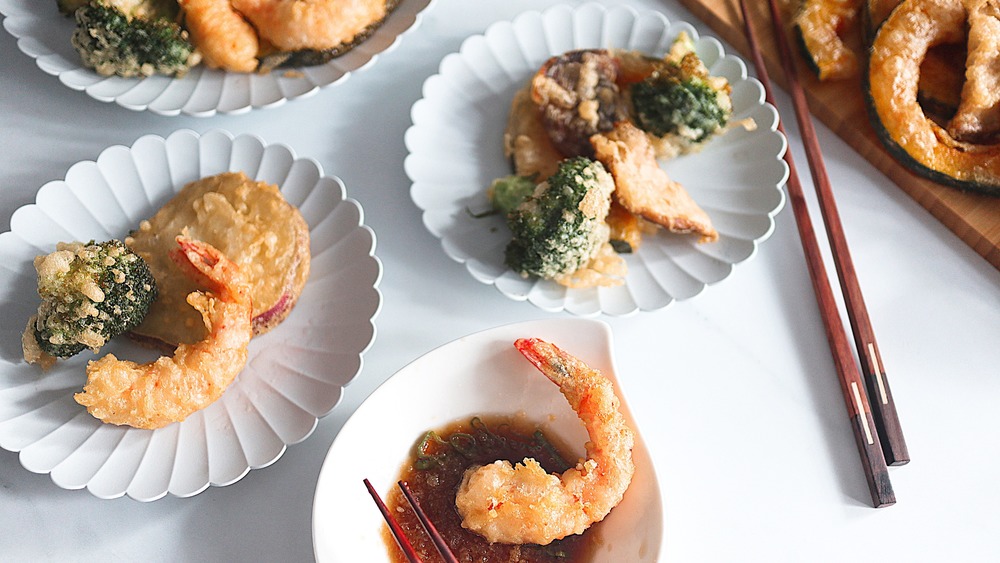
Ingredients
- ¾ cup water
- 1 teaspoon dashi
- 2 tablespoon soy sauce
- 2 tablespoon mirin
- 2 teaspoon sugar
- 8 large shrimp, peeled, tail on
- 4 shiitake mushrooms, cleaned, stems removed
- ¼ kabocha squash, peel on, scrubbed clean
- 1 sweet potato, peel on, scrubbed clean
- 1 small head of broccoli
- Canola oil for frying
- 1 ½ cup all purpose flour
- ¼ cup cornstarch
- 1 ½ tablespoons baking powder
- ½ teaspoon salt
- 1 ¾ - 2 cups seltzer, cold
- 2-inch piece daikon radish
- 1 tablespoon thinly sliced scallion, green part only
- Extra flour for dusting
Directions
- To make tempura dipping sauce, in a small saucepan over medium heat, combine water, dashi, soy sauce, mirin, and sugar and stir to combine.
- Let mixture come to a boil until sugar is completely dissolved, then pour into a separate bowl and set aside to cool.
- To prepare the shrimp, first cut small incisions on the top and bottom of shrimp, being careful not to cut too deep (this prevent shrimp from curling when cooked). Using the tip of a small pairing knife, carefully remove the vein from the top of the shrimp, then use paper towels to pat the shrimp dry and set aside on a plate.
- If mushrooms are large, cut in half. Cut kabocha squash and sweet potato into thin slices, approximately 1/4 inch thick. Cut broccoli into bite-sized pieces. Set all prepared vegetables aside on a plate.
- Fill a large pot halfway with oil and place thermometer on side of pot, then turn on medium heat and heat oil to 320 degrees Fahrenheit.
- While oil is heating, prepare the tempura batter by sifting the flour, cornstarch, baking powder, and salt into medium bowl.
- Pour 1 ¾ cup of cold seltzer into dry ingredients and whisk until combined, leaving some lumps (consistency should be similar to heavy cream). If the batter is too thick, slowly add a little more seltzer until it becomes the right consistency. Do not overmix!
- In order to keep the batter very cold, fill a large bowl with ice water. Place bowl with tempura batter inside the ice water bath until ready to use.
- Place a wire rack on top of a sheet tray lined with paper towels, and once the oil has come up to temperature, fry the vegetables in batches starting with the kabocha squash: Lightly coat in the flour, tapping off excess. Then, add to the tempura batter. Using chopsticks or tongs, lift a coated piece from the batter, letting excess drip off, and carefully place into hot oil. Do not overcrowd the pan. Only add 4 to 5 pieces at a time.
- Place tempura bowl back into ice water bath to keep batter cold. Fry veggies for approximately 3 minutes until tender, then remove from oil and place on wire rack to cool.
- Using a fine mesh sieve, remove all tempura pieces left in the oil. Repeat this in between each batch of frying.
- Let oil come back up to temperature before adding the next batch of vegetables, and continue the same process with the sweet potato, mushroom, and broccoli (the broccoli does not need to be coated in flour before adding to the batter), and place on wire rack to cool.
- Increase oil temperature to 350 degrees Fahrenheit, then lightly coat shrimp with flour. While holding the shrimp by the tail, dip in the tempura batter. Do not coat tail in the batter. Fry shrimp until cooked through, approximately 1 to 2 minutes depending on the size of your shrimp. Place on wire rack to cool.
- Peel and finely grate the daikon radish and squeeze the liquid out. Divide prepared dipping sauce into small bowls and place 1 teaspoon of the prepared daikon into each bowl. Top with sliced scallions.
- Serve tempura while hot.
Nutrition
| Calories per Serving | 884 |
| Total Fat | 63.0 g |
| Saturated Fat | 4.7 g |
| Trans Fat | 0.2 g |
| Cholesterol | 17.7 mg |
| Total Carbohydrates | 69.4 g |
| Dietary Fiber | 6.6 g |
| Total Sugars | 6.3 g |
| Sodium | 1,204.1 mg |
| Protein | 12.5 g |
